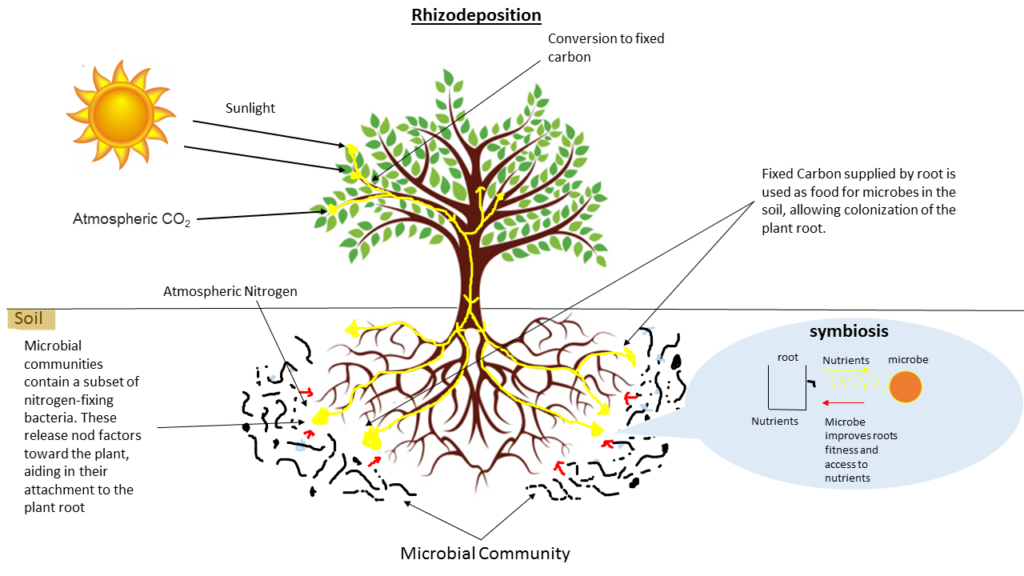Improving Soil Fertility
Farmers all agree that soil organic matter is the key to soil fertility and productivity. In the tropics, as soil organic matter decays very rapidly, cropping patterns must ensure ways and means to revitalise the soil. There are several forms of maintaining or increasing organic matter in soils:
- Addition of organic materials as organic amendments such as animal manures, composts, etc.
- Addition of organic matter through green manuring and/or cover crops.
- Addition of composting bio-cultures along with formulated natural extracts to accelerate crop residue breakdown and rapidly mobilise soil nutrients into the plant system.
- Addition of inorganic nutrients in amounts adequate for crop production, taking into consideration inorganic fertiliser uptake by the crop from the field.

Although elemental N occupies about 78% of the air by volume, this nitrogen is not used by most organisms. A group of bacteria, the Rhizobia group, or nodule bacteria, is able to utilize this free N by associating with legumes. Biological nitrogen fixation is the biochemical process by which elemental N is combined into organic forms. It is carried out by many species of bacteria (in association or not with legumes), some actinomycetes (a special group of bacteria), and blue-green algae (cyanobacteria). On a global scale, while chemical nitrogen production is approx. 75 million tonnes, requiring a highly energy-intensive process, it is estimated that around 150 million tonnes of N2 is fixed biologically, at a very nominal production cost.
Fallowing the field without plant residue returning to soils typically increases the rate of organic carbon depletion. Therefore, crop residue composting, through addition of composting bio-cultures, acquires prime importance to increase soil fertility.
The establishment of green manure crops, such as Daincha, prior to planting sugarcane, offers many potential agricultural and ecological benefits to the grower. Potential benefits from using green manure crops include production of organic matter to enrich the soil, ground cover to reduce wind erosion (soil), weed control (less herbicide required), reduced rainwater runoff, improved water infiltration and soil moisture retention, improved soil texture, and soil nutrient enhancement.
By improving soil organic matter, green manuring directly influences the soil water holding capacity by increasing water retention and lateral water movement within the soil. Further, since sugarcane is continuously cropped, season after season, this monoculture practice encourages certain diseases, weeds, or pests. One way to break the continuity of the pest cycle is by introducing an alternative crop.
Incorporating this crop residue into the soil will enhance soil fertility. Rapid decomposition through beneficial composting cultures will ensure optimum bio-availability of essential nutrients to the ensuing main sugarcane crop.
Oxygen for Soil Health and Fertility
As agricultural practices grow more intensive, and the usage of inorganic fertilisers continues to rise, problems with soluble salts can be expected to increase in the future, as the demand on water supplies increase. Soluble salt problems tend to increase under hot, dry summer conditions because water depletion from ground and surface waters concentrates the ions in solution. Moreover, the necessity of frequent irrigation during hot weather results in greater total salt accumulation in the root zone. The ions that commonly contribute to high soluble salts are chloride and sulfate, but mainly sodium.
Electrical conductivity (EC) is a measure of the total salt content of water based on the flow of electrical current through the sample. The higher the salt content, the greater is the flow of electrical current. A high EC in irrigation waters reduces plant growth by making it harder for the plants to absorb water. An EC above 1.0 mmhos/cm is cause for concern for most plants, but species sensitivity varies considerably. Sulphide toxicity is sometimes associated with water salinity, possibly because waters with higher electrical conductivity may contain higher concentrations of sulphide.
Aside from soil, the two basic ingredients necessary for healthy root systems are air and water. The spaces within a soil, known as soil pores, can be filled with liquid and/or gases. Physical, chemical, and biological soil factors that influence crop growth and yield depend on the relative proportions of these two phases within the root zone. A soil that is well aerated will favour increased root respiration and aerobic microbial activity. Conversely, in soils where the pores are filled with liquid, or waterlogged soils typical of poor drainage, anaerobic conditions will prevail.
Oxygen (O2) is essential for root respiration. However, immediately after the roots are submerged in water, they can no longer breathe normally. The liquid impedes diffusion of metabolites such as carbon dioxide and ethylene. This causes plant growth to be stunted because ethylene is a growth inhibitor. However, when air is available in the root zone, much of the ethylene gas is diffused away from the roots into the air within the root zone. This increased diffusion rate results in improved growing conditions.
Increased oxygen diffusion rates have shown to increase nitrogen (N2) fixation. The supply of available carbon and the supply of O2 both have major effects on symbiotic fixation. More adenosine triphosphate (ATP) is generated with increased levels of oxygen. Plants use ATP as the major carrier of phosphate and growth energy. Furthermore, increased N2 fixation can be attributed directly to an increase of atmospheric O2 in the root zone. The first regions to suffer oxygen deficiency are the regions of highest metabolic activity, such as the zones of cell division and elongation at the end of the roots. Therefore, oxygenating the root zone will result in reduced stress in the plant system.
Oxygen is also essential for most soil microorganisms. It has been estimated that in a fertile soil, as microorganisms thrive and multiply, they consume more oxygen than the standing crop plants. Oxygen is important for soil processes such as Nitrification and Ammonification, carried out by the Nitrosomonas and Nitrobacter species. Shortages of O2 can lead to denitrification, through which significant amounts of nitrogen are lost for crop production as volatile nitrogen compounds (nitrous oxide and nitric oxide) are produced and escape from the soil. In addition, oxygen is also needed for large groups of soil fauna. These include a number of insects, nematodes, mites, spiders and earthworms, which improve the soil physical, biological and chemical properties.
The most common anaerobic soil conditions are to be found in flooded areas. These anaerobic conditions are produced when the oxygen that is carried in the water is depleted. Because of the relatively smaller pore sizes inherent in clays, the O2 content in the root zone of these soils is depleted much more rapidly than in sandy soils. The oxygen in clays can be consumed within hours, whereas in sands it may take up to 3 days to deplete the O2 that is carried into the root zone.
It is therefore of paramount importance to supplement the oxygen in clay soils, such as sugarcane fields, to grow and harvest a healthy high-yielding crop.
- +65 98522454
- info@pranasaara.com
Icons from www.flaticon.com

